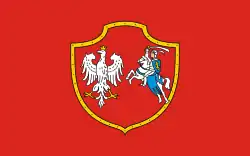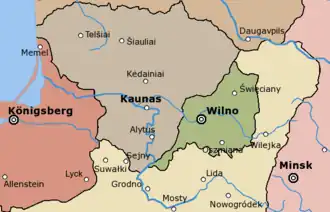Army of Central Lithuania


_left_wing_variant.svg.png)
_right_wing_variant.svg.png)

The Army of Central Lithuania was the armed forces of the state of Central Lithuania proclaimed by General Lucjan Żeligowski on October 12, 1920.

With the announcement by General Żeligowski of the establishment of Central Lithuania, the army which he commanded and which participated in the Żeligowski's Mutiny automatically became the Army of Central Lithuania. It was reincorporated into Polish Army in 1922 following Poland's annexation of Central Lithuania.
The original composition of the troops
- 1st Infantry Brigade
- 2nd Infantry Brigade
- Navahrudak Rifles Regiment – later 80th Infantry Regiment
- Hrodna Rifles Regiment – later 81st Hrodna Rifles Regiment
- 1st Lithuanian-Belarusian Field Artillery Regiment
- Mounted Riflemen Squadron
- 1st Sapper Company
- mjr. Kościałkowski's "Bieniakonie" (Benekainys) Group
- Kresy Battalion
- 216th Field Artillery Squadron
- Cavalry Squadron
Military operations
After the occupation of Vilnius, the Supreme Commander of the Army of Central Lithuania, General Żeligowski, ordered the troops to advance to the line: Trakai-Kraso (in Polish) (?)-Rykantai and Bendoriai-Riešė-Paraudondvariai.
Until 29 November 1920, when the Kaunas Armistice was concluded, Central Lithuania was in the state of an undeclared war with the Republic of Lithuania.
1st Central Lithuanian Army Corps
During the fighting, the Army of Central Lithuania was reorganized and on 16 October 1920, the 1st Central Lithuanian Army Corps was created. The corps commander was General Jan Rządkowski, the commander of the 1st Lithuanian-Belarusian Division.
- Command
- Commanding officer– gen. Jan Rządkowski
- Staff
- Chief of Staff – p.o. mjr SG Władysław Powierza
- Quartermaster– p.o. mjr SG Władysław Powierza
- Chief of the 4th Branch (Oddziału IV) – p.o. mjr SG Władysław Powierza
1st Division (Vilnius Infantry Brigade)
- Vilnius Rifles Regiment
- Minsk Rifles Regiment
2nd Division (2nd Hrodna Infantry Brigade)
- Navahrudak Rifles Regiment
- Hrodna Rifles Regiment
3rd Division
3rd Upper Nemunas Infantry Brigade
- 5th Volunteer Rifles Regiment
- 6th Scouts Rifles Regiment (after the dissolution of the 3rd Brigade and 5th Volunteers Rifles Regiment, the 6th Scouts Rifles Regiment was independent)
- 77th Infantry Regiment (two companies)
1st Artillery Brigade
- 1st Light Artillery Regiment
- two squadrons of the 216th Light Artillery Regiment
Cavalry Division of the Army of Central Lithuania
Reserve Brigade of the Army of Central Lithuania
Others
- Sapper Battalion
- Armoured Car Platoon
- Services
Benekainys Operational Group (Oct. 1921)
Location on 27 October 1921:[1]
| Infantry
Division |
Regiment | Garrison | |
|---|---|---|---|
| 19th
(HQ: Vilnius) |
Vilnius Rifles | Vilnius | |
| Minsk Rifles | |||
| Kaunas Rifles | |||
| 19th Field Artillery | |||
| 3rd Heavy Artillery | |||
| 29th
(HQ: Vilnius) |
Grodno Rifles | Vilnius | |
| Lida Rifles
(HQ: Benekainys) |
1st Battalion | Visgirdai | |
| 2nd Battalion | Šalčininkai | ||
| 3rd Battalion | Jeruzalė | ||
| Navahrudak Rifles | Vilnius | ||
| 29th Field Artillery | |||
| 29th Heavy Artillery Squadron,
III Squadron / 3rd Heavy Artillery | |||
| Cavalry
Brigade |
Uhlan Regiment | Squadron | Garrison |
|---|---|---|---|
| 3rd
(HQ: Vilnius) |
10th Lithuanian
(HQ: Lentvaris) |
1 | Rūdiškės |
| 2 | Lentvaris | ||
| 3 | Trakai | ||
| 4 | Valkininkai | ||
| Machine
carbine |
Trakai | ||
| Technical | Švenčionys | ||
| 13th Vilnius
(HQ: Vilnius) |
1 | Vilnius | |
| 2 | Paberžė | ||
| 3 | Trakai | ||
| 4 | Griciūnai | ||
| Machine
carbine |
Vilnius | ||
| Technical | |||
| 23rd Grodno
(HQ: Maišiagala) |
1 | Medžiukai | |
| 2 | Kiemeliai | ||
| 3 | Trakai, Paberžė | ||
| 4 | Paberžė | ||
| Machine
carbine |
Leoniškės | ||
| Technical | Maišiagala |